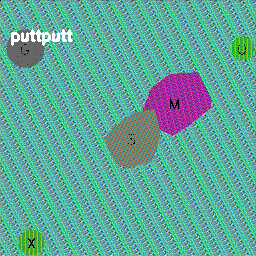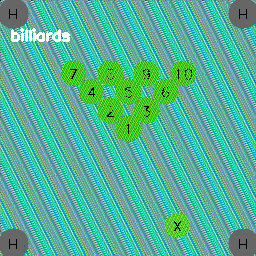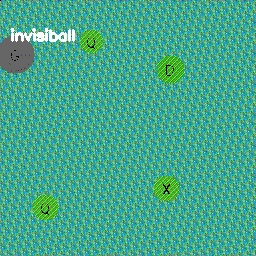The Sandbox Environment for Generalizable Agent Research (SEGAR) is a suite of research tools for studying Interactive Representation Learning (IRepL). IRepL is the study of the interplay between an agent's representation learning in an environment and the agent's interactions with this environment. As a field of study, IRepL researches two key questions: why and how do interactions help representation learning (RepL)? IRepL is distinct from but related to Reinforcement Learning (RL), focusing on how advances in RL can benefit representation learning and visa versa.
The Sandbox Environment for Generalizable Agent Research provides a setting for studying IRepL in the context of visual observations. It comes with a physics simulator that models dynamics under phenomena such as charge, magnetism, collisions, etc. As such, SEGAR is relevant to researching RepL and RL for robotics , although we anticipate lessons learned with SEGAR to be useful in a number of domains. SEGAR gives an experiment designer rich control over defining benchmark MDPs, making it easy to construct custom environments and tasks. Finally, SEGAR was designed with generalization in mind, so the generative factors of SEGAR environments (such as the charge, mass, or position of objects) can be distributional. This allows an experimenter to set and quantify generalization difficulty in terms of a distance between training and test task distributions.
Details on code and tutorials can be found here.
Throughout most of ML history, progress in areas that deal with high-dimensional weakly structured inputs -- chiefly computer vision (CV) and natural language processing (NLP) -- has relied on feature engineering. A major role of constructing low-dimensional features has been in generalizing knowledge across tasks, thereby enabling successful use of CV and NLP technology even in settings with scarce task-specific data. Deep learning has revolutionized CV and NLP by supplanting feature engineering with its more scalable and data-driven version, representation learning.
Encouraged by the impact of representation learning on CV, researchers have been attempting to replicate it in two related areas -- robotics and RL with visual observations. Despite some successes, the effect of representation learning on these fields has been more modest. In our opinion, this status quo is for the following reasons:
-
Successful decision-making in RL and robotics often relies on knowing latent features such as object mass as fragility. Such statically unobservable features can't be detected from a single image, because they are only weakly reflected in object appearance, or not all.
-
Many representation learning techniques, and even representations such as pretrained ResNet, that have been tried in RL and robotics were transplanted without modification from computer vision literature and operated on individual static images. As a result, these approaches fail to extract crucial statically unobservable features.
-
Interactive representation learning (IRepL) exploits multimodality in robotics and RL data by extracting features from sequences of observation images and actions and, in principle, can derive statically unobservable features. However, despite a lot of recent IRepL literature, IRepL research is still in its infancy. Connections between changes in statically unobservable features and representation generalization are poorly understood as well.
-
Progress towards such an understanding has been checked by the lack of benchmarks where researchers can vary the values of crucial unobservable features across tasks in a controlled fashion, measure the effect of these changes on generalization, and play with the degree of correlation between observable and unobservable features.
Thus, a key step towards making progress towards representation learning in sequential decision-making scenarios is creating a benchmarks that would enable controlled, informative experiments in this research ares. The Sandbox Environment for Generalizable Agent Research, the environment suite we present here, serves exactly that purpose.
There are a number of interesting and useful benchmarks available for training representations through interaction. SEGAR's key distinguishing feature -- which we believe to be crucial for making substantial progress in IRepL -- is giving researchers full control over constructing the training and test task distributions for answering specific representation learning questions the researchers are interested in. Namely:
-
SEGAR allows an experiment designer to inspect and modify all components of an environment MDP. This includes:
-
The evironment MDP's generative factors. For environments in popular existing benchmarks, e.g., Procgen and ALE, their generative factors such as the number of objects and their properties aren't easily available for modification or even inspection. This makes it difficult to understand what information the agent should be able to capture in a representation.
-
MDP dynamics. The evironment MDP's dynamics is parameterized by its generative factors. In SEGAR, users can easily inspect the dynamics model to understand how it is affected by changes in the generative factors and choose these factors' values to induce dynamics with a desired behavior. This makes SEGAR useful in studying causal inference.
-
Reward function. Reward functions defines tasks in an environment, and SEGAR allows an experiment designer to easily construct them. This makes SEGAR highly customizable, allowing researchers to construct tasks that depend on subsets of factors of the environment, and contrasts with most existing benchmarks used in RepL literature, which make defining new tasks non-trivial if at all possible.
-
Visual features. We believe that providing observations to the agent based on visual features that are understandable by humans may unintentionally introduce experimental challenges, as neural networks can leverage low-level visual cues to "cheat" at tasks that were intended to require higher-level reasoning. In SEGAR, the visual features are treated as a transparent and controllable variable in building experiments, such that the research can control how the underlying factors are expresses in terms of pixels, if at all.
-
-
SEGAR allows defining training and test task distributions for generalization experiments. Such experiments are a major motivation behind SEGAR's design, and SEGAR makes them easy to set up by specifying distributions over generative factors' values for training and test tasks. In popular benchmarks such as Procgen and MetaWorld, these distributions are usually predefined and fixed, so an experiment designer has no control over the generalization gap that a learned representation is expected to bridge.
-
SEGAR is lightweight. Some physics-based benchmark suites, e.g., dm_control, also provide a significant degree of control over environment design. However, 3D physics simulation makes them computationally expensive. SEGAR is based on the insight that most questions about representation learning from images are applicable just as well in a set of lightweight 2D environments that can be tested on quickly to make progress in IRepL and related areas.
-
What properties of an environment and a task in it determine whether we need to infer statically unobservable state features (and hence use IRepL)?
-
What properties of a task distribution necessitate learning all statically unobservable features in the MDP's generative model, such as masses and charges of all objects?
-
Does interactive RepL provide an edge to models ultimately meant for static tasks such as classification and segmentation, versus traditional RepL methods that use static i. i.d. data?
-
How do representations trained on static data differ from those learned from interactive data?
-
Can we develop better algorithms for learning statically unobservable features relevant to sequential decision-making?
-
How can we most effectively learn the part of the underlying causal graph of the MDP, including statically unobservable variables, relevant to learning (near-)optimal policies?
-
How can we exploit RepL to learn better policies, better interventions, and better exploration policies for agent learning?
-
What are the roles of priors in unsupervised representation learning when data is drawn from interactions that depend on said representations?
-
How can IRepL make the most use of offline interaction data and thereby help offline RL algorithms?
We informally say that a representation generalizes well from a training to a test task distribution if it allows learning (or transferring, in the case of zero-shot generalization) a near-optimal test distribution policy that is linear in the representation's features. Some of the relevant questions that SEGAR facilitates studying are:
-
How do we learn representations that generalize across specific kinds of differences between training and test task distributions?
-
What assumptions do we need to make on the collection of online interactive data and coverage of offline interactive data in order to enable generalization across various differences between training and test task distributions?
-
What properties of training and test task distribution determine whether we need to infer statically unobservable state features (and hence use IRepL)? E.g., inferring the charge of colliding metal balls may or may not be important for a generalizable representation for predicting their future positions, depending on how small their masses can be in the test task distribution.
-
Create and activate a conda virtual environment:
conda create -n segar pip python=3.6 conda activate segar -
Clone the current repo and install it in editable mode:
git clone https://github.com/microsoft/roboputtputt.git cd roboputtputt pip install -e . -
For running RL samples (using rllib):
pip install -e '.[rl]' -
For pytorch installation:
- On CPU-only machines:
conda install pytorch=1.7.0 torchvision cpuonly -c pytorch- On machines with a GPU:
conda install pytorch=1.7.0 torchvision cudatoolkit=10.1 -c pytorch
For tutorials on the features of SEGAR, including running experiments,
creating environments, etc, please see segar/README.md.
Segar is designed to be extensible and for users to design their own environments. To help users get started, it includes a handful of OpenAI-Gym compatible environments for training RL agents to play puttputt/minigolf.
The agent controls the (player-)ball by applying a 2D continuous force vector. The goal is to navigate the ball to the goal through obstacles.
- Action space:
(2,), np.float32, [-1,1]- 2D force vector to apply to the ball - Observation space:
(64,64,3), np.uint8, [0,255]- top-down color image. - Reward: Current distance between ball and goal.
The environments follow the format:
Segar-TASK-DIFFICULTY-OBSERVATION-v0
...where we have
TASK: one ofempty,objectsxN, ortilesxNandNis one of1,2,3TASK:emptyis an empty square arena with one goal and one ball.TASK:objectsxNis a square arena with a goal, a ball, andNother random objects (like other non-player balls or magnets)TASK:tilesxNis a square arena with a goal, a ball, andNrandom patches of random materials (like sand or lava)
DIFFICULTY: one ofeasy,medium, orhard. Generally, in the easy case, the ball and goal are in fixed positions, in the medium case, the ball starts at the bottom of the arena and the goal is always at the top, and in the hard case, the ball and goal can be anywhere, uniformly.OBSERVATION: currently onlyrgb. We will include different modalities later. This corresponds to the observation space64x64x3innp.uint8(i.e. a color image of 64x64 pixels)
So for example, we have Segar-empty-easy-rgb-v0 or Segar-tilesx3-hard-rgb-v0. The complete list of current
environments can be found at the bottom of the file segar/__init__.py.
All environments are registered when you call import segar.
More details about the specs of each environment can be found in the env.py file:
segar/envs/env.py
This project welcomes contributions and suggestions. Most contributions require you to agree to a Contributor License Agreement (CLA) declaring that you have the right to, and actually do, grant us the rights to use your contribution. For details, visit https://cla.opensource.microsoft.com.
When you submit a pull request, a CLA bot will automatically determine whether you need to provide a CLA and decorate the PR appropriately (e.g., status check, comment). Simply follow the instructions provided by the bot. You will only need to do this once across all repos using our CLA.
This project has adopted the [Microsoft Open Source Code of Conduct] (https://opensource.microsoft.com/codeofconduct/). For more information see the Code of Conduct FAQ or contact [opencode@microsoft.com] (mailto:opencode@microsoft.com) with any additional questions or comments.
This project may contain trademarks or logos for projects, products, or services. Authorized use of Microsoft trademarks or logos is subject to and must follow Microsoft's Trademark & Brand Guidelines. Use of Microsoft trademarks or logos in modified versions of this project must not cause confusion or imply Microsoft sponsorship. Any use of third-party trademarks or logos are subject to those third-party's policies.


